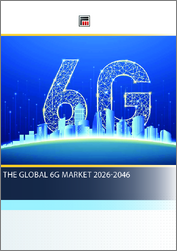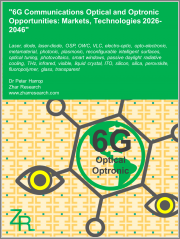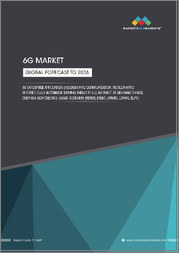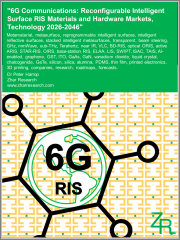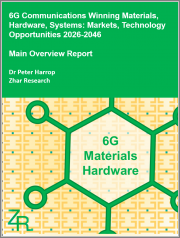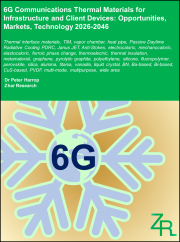
|
시장보고서
상품코드
1808600
세계의 6G 기술 시장 : 컴포넌트별, 기술별, 통신 인프라별, 용도별, 최종 사용자 산업별 예측(2025-2030년)6G Technology Market by Component, Technology, Communication Infrastructure, Application, End-User Industry - Global Forecast 2025-2030 |
||||||
6G 기술 시장의 2024년 시장 규모는 16억 6,000만 달러로 평가되었고, 2025년에는 23억 8,000만 달러로 추정되며, CAGR 44.17%로 성장할 전망이며, 2030년에는 149억 4,000만 달러에 이를 것으로 예측되고 있습니다.
| 주요 시장 통계 | |
|---|---|
| 기준 연도(2024년) | 16억 6,000만 달러 |
| 추정 연도(2025년) | 23억 8,000만 달러 |
| 예측 연도(2030년) | 149억 4,000만 달러 |
| CAGR(%) | 44.17% |
6G 커넥티비티의 새벽을 그리는 세계의 통신과 산업 생태계를 변화시키는 차세대 무선 진화의 도입
5세대 네트워크에서 6G로의 전환은 단순한 세대 교체가 아니라 초고신뢰성, 초저지연 통신과 모든 산업을 변화시키는 용도에 대한 융합의 도래를 말하는 것입니다. 연결성에 대한 요구가 커짐에 따라 6G는 네트워크 코어에 인공지능과 머신러닝을 네이티브로 통합하여 전례없는 데이터 속도와 광범위한 인텔리전스를 실현할 것을 약속합니다. 엣지 컴퓨팅은 테라헤르츠파 전파와 양자 통신 프로토콜과 시너지 효과를 발휘하여 몰입형 증강현실 체험, 자율형 모빌리티 에코시스템, 미션 크리티컬한 산업 자동화 등을 지원합니다.
패러다임을 바꾸는 기술과 시장 파괴를 풀어 6세대 무선 네트워크의 전례 없는 진보를 촉진
6G의 출현은 기술과 시장 역학 모두에서 일련의 패러다임 시프트적 진보를 특징으로 합니다. 인공지능 및 머신러닝은 엣지 대응 분석에서 완전히 자율적인 네트워크 제어 루프로 이동하여 자체 복구 토폴로지와 적응 자원 할당을 촉진합니다. 동시에, 테라헤르츠파 기술은 새로운 스펙트럼의 프론티어를 풀어주고, 기존의 고정 회선이나 셀룰러 회선을 보완하면서, 단거리에서의 멀티기가비트 통신을 가능하게 합니다. 아직 개발 도상 양자 통신은 해독 불가능한 암호화 체계를 통해 데이터 보안에 혁명을 가져와 세계 네트워크의 기본적인 신뢰 모델을 변화시킬 것으로 기대되고 있습니다.
미국 무역 관세가 6G 개발에서 부품 공급망 및 혁신 궤도에 미치는 원대한 영향 평가
2025년 미국 무역 관세의 발동은 세계 6G 공급망과 혁신 파이프라인에 복잡한 과제를 가져왔습니다. 중요한 반도체 부품 및 네트워크 인프라 모듈에 대한 관세 인상은 제조업체가 조달 전략을 재검토하고 지역 다양화 및 니어 쇼어링 노력을 가속화하고 있습니다. 결과적으로 하드웨어 공급업체는 대체 주조소 및 전략적 파트너와 새로운 파트너십을 맺고 단일 소스에 대한 의존성을 완화하는 반면 소프트웨어 및 서비스 회사는 라이선스 모델을 재조정하고 비용 상승 압력을 흡수하려고 합니다.
다면적 시장 세분화의 틀을 읽어서 컴포넌트 기술의 인프라 애플리케이션 및 업계 역학을 밝힙니다.
6세대 무선 시장은 컴포넌트, 기술, 인프라, 애플리케이션 및 최종 사용자의 역학을 깊이 파악하는 복잡한 세분화 스키마에 의해 정의됩니다. 구성 요소 측면에서 네트워크 인프라는 고급 무선 장치에서 핵심 네트워크 스위치에 이르기까지 사용자 장치 계층은 스마트폰, 웨어러블 터미널 및 산업용 엔드 포인트에 이르기까지 모든 것을 포함합니다. 컨설팅 서비스, 네트워크 관리, 지원 및 유지보수, 시스템 통합이 통합되어 견고한 서비스 에코시스템을 형성하며, 네트워크 최적화, 관리 스위트부터 종합적인 보안 플랫폼에 이르는 소프트웨어 스택으로 보완됩니다.
아메리카, 유럽, 중동, 아프리카, 아시아태평양의 지역 역학을 평가하고 6G 도입과 전개의 다양한 길을 그립니다.
6G 전환의 지역 역학은 아메리카, 유럽, 중동 및 아프리카, 아시아태평양에서 각각 다른 궤도를 따라 전개되고 있습니다. 아메리카에서는 북미 통신 사업자와 기술 공급자가 테라헤르츠 대역 및 엣지 컴퓨팅 솔루션의 도시 규모 평가판에서 협력하고 있는 반면, 라틴아메리카 시장에서는 연결 갭을 메우기 위한 디지털 포섭 이니셔티브와 관민 파트너십이 중시되고 있습니다. 이러한 미묘한 접근 방식은 인프라의 현대화와 긴밀한 혁신 프로그램이 공존하는 환경을 조성하고 있습니다.
6G 영역 경쟁 구도 및 혁신 생태계를 형성하는 업계 선도 기업과 전략적 제휴 프로파일링
6G 영역의 주요 기업은 전략적 파트너십을 구축하고 칩 설계, 네트워크 인프라, 소프트웨어 에코시스템에 걸친 통합 혁신 의제를 추구하고 있습니다. 반도체 리더는 에너지 효율적인 무선 주파수 모듈 및 테라헤르츠 주파수에 최적화된 고급 안테나 시스템을 개발하기 위해 최첨단 장비 공급업체와 협력하고 있습니다. 동시에 네트워크 장비 공급자는 예측 유지 보수 및 적응형 네트워크 슬라이싱을 위한 인공지능 에이전트를 통합하여 서비스 포트폴리오를 심화시키고 신뢰성 및 고객 경험을 모두 강화합니다.
6G 도입 파트너십과 지속 가능한 성장을 가속화하기 위해 업계 리더에게 전략적 중요성 및 로드맵 가이드라인 제공
6세대 배포의 복잡성을 극복하고 새로운 기회를 활용하기 위해 업계 리더는 다면적인 전략을 채택해야 합니다. 첫째, 테라헤르츠파 전파와 양자통신에 초점을 맞춘 연구개발 컨소시엄에 대한 지속적인 투자는 기술적 리더십을 확보하는데 필수적입니다. 동시에 반도체, 소프트웨어 및 서비스의 역량을 통합하는 크로스 섹터 파트너십을 구축하여 시장 출시 시간을 단축하고 밸류체인의 시너지 효과를 높일 수 있습니다.
종합적인 6세대 무선 시장 인사이트을 지원하는 엄격한 조사 설계 데이터 수집 기술 및 분석 프레임워크 해명
본 조사에서는 6세대 무선 시장에 대한 종합적인 인사이트를 제공하기 위해 1차 조사와 2차 조사를 조합한 엄격한 하이브리드 조사 방법을 채용하고 있습니다. 1차 설문조사는 C-레벨 경영진, 네트워크 설계자, 정책 입안자, 기술 혁신자와 면밀한 인터뷰를 실시하여 전략적 우선순위, 기술적 과제 및 파트너십 모델에 대한 원시 관점을 제공했습니다. 이러한 질적 입력은 산업 보고서, 백서, 규제 당국에 제출된 서류 및 공공 발표에서 얻은 양적 데이터와 삼각 비교했습니다.
6G 대응 생태계의 성숙과 하이퍼커넥티드 퓨처를 위한 이해관계자를 이끄는 전략적 과제에 대한 종합적인 결론의 도출
통신 업계가 6G의 수평선을 향해 진행됨에 따라 최첨단 기술, 진화하는 비즈니스 모델, 지정학적 힘이 상호 작용하여 세계 커넥티비티의 형태가 정해져 갈 것으로 보입니다. 인공지능, 테라헤르츠, 양자통신, 엣지 컴퓨팅의 융합은 전례 없는 수준의 자동화, 몰입감, 신뢰성을 지원할 수 있는 네트워크의 패러다임을 예고하고 있습니다. 그러나 공급망의 재구성과 관세의 변동으로 인해 이해관계자들은 다양화와 협력을 통한 탄력성을 추구해야 합니다.
목차
제1장 서문
제2장 조사 방법
제3장 주요 요약
제4장 시장 개요
제5장 시장 역학
- 다양한 6G 대응 디바이스 및 플랫폼 간의 원활한 상호 운용성을 실현하기 위한 표준화의 노력
- 6G 전개에서 신호 커버리지를 강화하기 위한 재구성 가능한 인텔리전트 서피스의 채용
- 6G 네트워크에서 초고속 데이터 전송을 위한 테라헤르츠 통신 통합
- 6G 아키텍처에서 적응형 리소스 할당을 위한 지능형 네트워크 슬라이싱 도입
- 6G 성능 예측 최적화를 위한 AI 구동형 네트워크 관리 시스템 개발
- 녹색 6G 네트워크 운영을 위한 에너지 효율적인 프로토콜에 초점을 맞춘 지속가능성 이니셔티브
- 6G 에코시스템에서 저지연 서비스를 지원하기 위한 엣지 컴퓨팅 기능의 확장
- 차세대 6G 통신 인프라의 보안 확보를 위한 양자키 분배의 구현
제6장 시장 인사이트
- Porter's Five Forces 분석
- PESTEL 분석
제7장 미국 관세의 누적 영향(2025년)
제8장 6G 기술 시장 : 컴포넌트별
- 하드웨어
- 네트워크 인프라 구성 요소
- 사용자 디바이스
- 서비스
- 컨설팅 서비스
- 네트워크 관리
- 지원 및 유지 보수
- 시스템 통합
- 소프트웨어
- 네트워크 최적화 및 관리 소프트웨어
- 보안 소프트웨어
제9장 6G 기술 시장 : 기술별
- 인공지능(AI) 및 머신러닝
- 엣지 컴퓨팅
- 양자통신
- 테라헤르츠파
제10장 6G 기술 시장 통신 : 인프라별
- 고정
- 무선
- 광대역
- 셀룰러
제11장 6G 기술 시장 : 용도별
- 자율 이동
- 확장 모바일 광대역
- 몰입형 AR/VR
- 산업 자동화 및 로봇 공학
- 실시간 미디어 및 협업
- 원격 헬스케어 및 원격 의료
- 스마트 인프라
제12장 6G 기술 시장 : 최종 사용자 업계별
- 자동차
- 은행, 금융서비스 및 보험(BFSI)
- 가전
- 교육
- 헬스케어
- 제조업
- 미디어 및 엔터테인먼트
- 통신 및 IT
제13장 아메리카의 6G 기술 시장
- 미국
- 캐나다
- 멕시코
- 브라질
- 아르헨티나
제14장 유럽, 중동 및 아프리카의 6G 기술 시장
- 영국
- 독일
- 프랑스
- 러시아
- 이탈리아
- 스페인
- 아랍에미리트(UAE)
- 사우디아라비아
- 남아프리카
- 덴마크
- 네덜란드
- 카타르
- 핀란드
- 스웨덴
- 나이지리아
- 이집트
- 튀르키예
- 이스라엘
- 노르웨이
- 폴란드
- 스위스
제15장 아시아태평양의 6G 기술 시장
- 중국
- 인도
- 일본
- 호주
- 한국
- 인도네시아
- 태국
- 필리핀
- 말레이시아
- 싱가포르
- 베트남
- 대만
제16장 경쟁 구도
- 시장 점유율 분석(2024년)
- FPNV 포지셔닝 매트릭스(2024년)
- 경쟁 분석
- AT&T, Inc.
- Deutsche Telekom AG
- Huawei Technologies Co., Ltd.
- Intel Corporation
- Keysight Technologies, Inc.
- KT Corporation
- LG Corporation
- NEC Corporation
- Nippon Telegraph and Telephone Corporation
- Nokia Corporation
- Qualcomm Incorporated
- Resonac Holdings Corporation
- Samsung Electronics Co., Ltd.
- SK Telecom Co., Ltd.
- Telefonaktiebolaget LM Ericsson
- Telefonica, SA
- ZTE Corporation
제17장 리서치 AI
제18장 리서치 통계
제19장 리서치 컨택
제20장 리서치 기사
제21장 부록
AJY 25.09.16The 6G Technology Market was valued at USD 1.66 billion in 2024 and is projected to grow to USD 2.38 billion in 2025, with a CAGR of 44.17%, reaching USD 14.94 billion by 2030.
| KEY MARKET STATISTICS | |
|---|---|
| Base Year [2024] | USD 1.66 billion |
| Estimated Year [2025] | USD 2.38 billion |
| Forecast Year [2030] | USD 14.94 billion |
| CAGR (%) | 44.17% |
Charting the Dawn of 6G Connectivity Embracing Next-Generation Wireless Evolution to Transform Global Communications and Industry Ecosystems
The transition from fifth-generation networks to the nascent realm of 6G represents more than a generational leap; it heralds the convergence of ultra-reliable, ultra-low-latency communications with transformative applications across every industry vertical. As connectivity demands intensify, 6G promises to deliver unprecedented data speeds and pervasive intelligence through native integration of artificial intelligence and machine learning at the network core. In this unfolding era, edge computing will synergize with terahertz wave propagation and quantum communication protocols to support immersive extended reality experiences, autonomous mobility ecosystems, and mission-critical industrial automation.
Moreover, next-generation network infrastructure components and user devices will evolve in lockstep, driven by modular, software-defined architectures that enable dynamic resource orchestration and advanced security frameworks. Against this backdrop, stakeholders must align research and deployment roadmaps to emerging spectrum allocations, interoperability standards, and sustainability imperatives. By charting the dawn of 6G development, decision-makers can position their organizations to harness disruptive innovations and cultivate resilient, high-performance network ecosystems on a global scale.
Unveiling the Paradigm-Altering Technological and Market Disruptions Set to Drive Unprecedented Advances in Sixth-Generation Wireless Networks
The emergence of 6G will be characterized by a series of paradigm-shifting advances in both technology and market dynamics. Artificial intelligence and machine learning will migrate from edge-enabled analytics toward fully autonomous network control loops, facilitating self-healing topologies and adaptive resource allocation. Concurrently, terahertz wave technologies will unlock new spectral frontiers, enabling multi-gigabit communications over short distances while complementing traditional fixed and cellular links. Quantum communication, still in nascent development, promises to revolutionize data security through unbreakable encryption schemes, transforming the foundational trust model of global networks.
In parallel, business models will evolve to incorporate network-as-a-service offerings, blending consulting, integration, optimization, and security capabilities into cohesive solutions tailored for diverse verticals. Ecosystem partnerships are expected to proliferate, uniting semiconductor innovators, infrastructure providers, system integrators, and software developers under collaborative research consortia. Together, these transformative shifts will chart a new trajectory for hyperconnected societies, laying the groundwork for an era in which data-driven intelligence and ultra-responsive communications converge seamlessly.
Assessing the Far-Reaching Effects of United States Trade Tariffs on Component Supply Chains and Innovation Trajectories in 6G Development
The imposition of United States trade tariffs in 2025 has introduced complex challenges across global 6G supply chains and innovation pipelines. Elevated duties on critical semiconductor components and network infrastructure modules have prompted manufacturers to reassess sourcing strategies, accelerating efforts toward regional diversification and near-shoring. As a result, hardware vendors are forging new alliances with alternative foundries and strategic partners to mitigate exposure to single-source dependencies, while software and services firms are recalibrating licensing models to absorb incremental cost pressures.
Despite these headwinds, the cumulative impact of tariff policies has also incentivized investment in domestic research facilities and advanced packaging technologies. Telecommunications operators and equipment providers are collaborating on pilot deployments to validate design resilience under shifting cost structures, fostering innovation in modular hardware architectures and automated system integration. Ultimately, the trade dynamics of 2025 are reshaping competitive landscapes, compelling stakeholders to adopt agile procurement frameworks and long-term collaboration roadmaps that bolster both security of supply and technological leadership in 6G development.
Decoding the Multifaceted Market Segmentation Framework to Illuminate Component Technology Infrastructure Application and Industry Dynamics
The sixth-generation wireless market is defined by an intricate segmentation schema that offers deep insights into component, technology, infrastructure, application, and end-user dynamics. On the component front, network infrastructure encompasses everything from advanced radio units to core network switches, while the user device layer spans smartphones, wearables, and industrial endpoints. Consulting services, network management, support and maintenance, and system integration together form a robust services ecosystem, complemented by software stacks ranging from network optimization and management suites to comprehensive security platforms.
Technological segmentation further highlights the critical role of artificial intelligence and machine learning in automating network operations, edge computing nodes that distribute processing closer to data sources, quantum communication channels that prioritize data integrity, and terahertz wave solutions that extend capacity at unprecedented bandwidths. Communication infrastructure is bifurcated into fixed and wireless assets, with wireless capabilities subdivided into broadband connectivity for home and enterprise, and cellular deployments spanning macro- and small-cell architectures. Application segmentation underscores pivotal use cases such as autonomous mobility corridors, enhanced mobile broadband experiences, immersive augmented and virtual reality environments, industrial automation and robotics lines, real-time collaborative media platforms, remote healthcare and telemedicine networks, and smart infrastructure deployments in urban and industrial settings. Finally, the breadth of end-user industry coverage-from automotive and banking, financial services and insurance to consumer electronics, education, healthcare, manufacturing, media and entertainment, and telecommunications and IT-reveals the vast market potential and sector-specific requirements that will shape 6G adoption trajectories.
Evaluating Regional Dynamics Across Americas Europe Middle East Africa and Asia-Pacific to Map Divergent Paths of 6G Adoption and Deployment
Regional dynamics in the 6G transition are unfolding along distinct trajectories across the Americas, Europe Middle East Africa, and Asia-Pacific. In the Americas, North American carriers and technology providers are collaborating on city-scale trials of terahertz and edge computing solutions, while Latin American markets emphasize digital inclusion initiatives and public-private partnerships to bridge connectivity gaps. This nuanced approach is fostering an environment where infrastructure modernizations coexist with targeted innovation programs.
In Europe, Middle East, and Africa, regulatory harmonization efforts by the European Union are setting the stage for coordinated spectrum releases and cross-border network interconnectivity, even as individual nations within the region pursue bespoke 6G research consortia. The Middle East is leveraging sovereign investment funds to underwrite pilot deployments in smart cities, and Africa is prioritizing leapfrog strategies that integrate wireless broadband with community-centric services.
Meanwhile, Asia-Pacific continues to lead in large-scale trials and commercial rollouts, propelled by strong government backing in countries like China, Japan, South Korea, and India. Industry alliances are driving advances in chip design, open-RAN architectures, and system integration, creating a competitive landscape that balances national ambitions with cross-regional collaboration to accelerate 6G commercialization.
Profiling Leading Industry Players and Strategic Collaborations Shaping the Competitive Landscape and Innovation Ecosystems in the 6G Domain
Leading companies in the 6G domain are forging strategic partnerships and pursuing integrated innovation agendas that span chip design, network infrastructure, and software ecosystems. Semiconductor leaders are collaborating with tier-one equipment vendors to develop energy-efficient radio frequency modules and advanced antenna systems optimized for terahertz frequencies. At the same time, network equipment providers are deepening their service portfolios by embedding artificial intelligence agents for predictive maintenance and adaptive network slicing, enhancing both reliability and customer experience.
System integrators and consulting firms are co-creating turnkey solutions that streamline deployment across edge and core environments, often bundling network optimization software with security platforms to address emerging threat vectors. Additionally, new entrants specializing in quantum encryption and open-RAN software are forging alliances with traditional telecom players, accelerating the maturation of interoperable ecosystems. Collectively, these collaborative approaches are redefining competitive boundaries and laying the groundwork for accelerated innovation, cost efficiencies, and market differentiation in the race to commercialize 6G.
Delivering Strategic Imperatives and Roadmap Guidelines for Industry Leaders to Accelerate 6G Implementation Partnerships and Sustainable Growth
To navigate the complexities of sixth-generation deployment and capitalize on emerging opportunities, industry leaders should embrace a multifaceted strategy. First, sustained investment in R&D consortia focused on terahertz wave propagation and quantum communication will be essential to secure technical leadership. Simultaneously, forging cross-sector partnerships that integrate semiconductor, software, and services competencies will accelerate time to market and enrich value-chain synergies.
Further, organizations must prioritize talent acquisition and upskilling initiatives to cultivate specialized expertise in advanced network orchestration, cybersecurity, and AI algorithm development. Adopting modular, software-defined architectures will enhance network agility and facilitate incremental upgrades, while proactive engagement with regulators on spectrum policy and standards development will ensure favorable operating environments. Lastly, embedding sustainability metrics into procurement and design processes will not only support corporate social responsibility objectives but also resonate with increasingly eco-conscious customers and investors. Through these strategic imperatives, stakeholders can position themselves at the forefront of the 6G evolution.
Elucidating Rigorous Research Design Data Acquisition Techniques and Analytical Frameworks Underpinning Comprehensive Sixth-Generation Wireless Market Insights
This study employs a rigorous, hybrid methodology combining primary and secondary research to deliver comprehensive insights into the sixth-generation wireless market. Primary research involved in-depth interviews with C-level executives, network architects, policy makers, and technology innovators, providing firsthand perspectives on strategic priorities, technical challenges, and partnership models. These qualitative inputs were triangulated with quantitative data obtained from industry reports, whitepapers, regulatory filings, and public announcements.
Data acquisition was supplemented by analysis of patent filings, technology roadmaps, and spectrum allocation plans to validate emerging trends. A multi-layered analytical framework was then applied, encompassing SWOT examinations of key segments, competitive benchmarking, and ecosystem mapping. Findings underwent iterative validation through expert panels and cross-regional workshops to ensure robustness and relevance. This research approach delivers both depth and breadth, equipping decision-makers with an authoritative foundation for strategic planning and investment in the 6G domain.
Drawing Comprehensive Conclusions on 6G Readiness Ecosystem Maturation and Strategic Imperatives Guiding Stakeholders Toward a Hyperconnected Future
As the telecommunications industry advances toward the 6G horizon, the interplay of cutting-edge technologies, evolving business models, and geopolitical forces will define the shape of global connectivity. The convergence of artificial intelligence, terahertz and quantum communication, and edge computing heralds a network paradigm capable of supporting unprecedented levels of automation, immersion, and reliability. Yet the journey to commercialization is not without complexity, as supply chain realignments and tariff dynamics compel stakeholders to pursue resilience through diversification and collaboration.
By embracing a holistic segmentation lens and acknowledging regional distinctions, organizations can tailor strategies that address both universal challenges and market-specific nuances. Leading companies are already establishing cross-industry alliances and modular architectures to accelerate innovation cycles. Moving forward, success will hinge on proactive engagement in standards development, sustainable design practices, and dynamic partnership ecosystems. With these imperatives in focus, industry participants are poised to unlock the full potential of 6G, ushering in a new era of hyperconnectivity and inclusive digital transformation.
Table of Contents
1. Preface
- 1.1. Objectives of the Study
- 1.2. Market Segmentation & Coverage
- 1.3. Years Considered for the Study
- 1.4. Currency & Pricing
- 1.5. Language
- 1.6. Stakeholders
2. Research Methodology
- 2.1. Define: Research Objective
- 2.2. Determine: Research Design
- 2.3. Prepare: Research Instrument
- 2.4. Collect: Data Source
- 2.5. Analyze: Data Interpretation
- 2.6. Formulate: Data Verification
- 2.7. Publish: Research Report
- 2.8. Repeat: Report Update
3. Executive Summary
4. Market Overview
- 4.1. Introduction
- 4.2. Market Sizing & Forecasting
5. Market Dynamics
- 5.1. Standardization efforts for seamless interoperability across diverse 6G-enabled devices and platforms
- 5.2. Adoption of reconfigurable intelligent surfaces for enhanced signal coverage in 6G deployments
- 5.3. Integration of terahertz communication for ultra-high-speed data transfer in 6G networks
- 5.4. Deployment of intelligent network slicing for adaptive resource allocation in 6G architectures
- 5.5. Development of AI-driven network management systems for predictive 6G performance optimization
- 5.6. Sustainability initiatives focusing on energy-efficient protocols for green 6G network operations
- 5.7. Expansion of edge computing capabilities to support low-latency services in 6G ecosystems
- 5.8. Implementation of quantum key distribution to secure next-generation 6G communications infrastructure
6. Market Insights
- 6.1. Porter's Five Forces Analysis
- 6.2. PESTLE Analysis
7. Cumulative Impact of United States Tariffs 2025
8. 6G Technology Market, by Component
- 8.1. Introduction
- 8.2. Hardware
- 8.2.1. Network Infrastructure Components
- 8.2.2. User Devices
- 8.3. Services
- 8.3.1. Consulting Services
- 8.3.2. Network Management
- 8.3.3. Support & Maintenance
- 8.3.4. System Integration
- 8.4. Software
- 8.4.1. Network Optimization & Management Software
- 8.4.2. Security Software
9. 6G Technology Market, by Technology
- 9.1. Introduction
- 9.2. Artificial Intelligence (AI) and Machine Learning
- 9.3. Edge Computing
- 9.4. Quantum Communication
- 9.5. Terahertz Waves
10. 6G Technology Market, by Communication Infrastructure
- 10.1. Introduction
- 10.2. Fixed
- 10.3. Wireless
- 10.3.1. Broadband
- 10.3.2. Cellular
11. 6G Technology Market, by Application
- 11.1. Introduction
- 11.2. Autonomous Mobility
- 11.3. Enhanced Mobile Broadband
- 11.4. Immersive AR/VR
- 11.5. Industrial Automation & Robotics
- 11.6. Real-Time Media & Collaboration
- 11.7. Remote Healthcare & Telemedicine
- 11.8. Smart Infrastructure
12. 6G Technology Market, by End-User Industry
- 12.1. Introduction
- 12.2. Automotive
- 12.3. Banking, Financial Services & Insurance (BFSI)
- 12.4. Consumer Electronics
- 12.5. Education
- 12.6. Healthcare
- 12.7. Manufacturing
- 12.8. Media & Entertainment
- 12.9. Telecommunications & IT
13. Americas 6G Technology Market
- 13.1. Introduction
- 13.2. United States
- 13.3. Canada
- 13.4. Mexico
- 13.5. Brazil
- 13.6. Argentina
14. Europe, Middle East & Africa 6G Technology Market
- 14.1. Introduction
- 14.2. United Kingdom
- 14.3. Germany
- 14.4. France
- 14.5. Russia
- 14.6. Italy
- 14.7. Spain
- 14.8. United Arab Emirates
- 14.9. Saudi Arabia
- 14.10. South Africa
- 14.11. Denmark
- 14.12. Netherlands
- 14.13. Qatar
- 14.14. Finland
- 14.15. Sweden
- 14.16. Nigeria
- 14.17. Egypt
- 14.18. Turkey
- 14.19. Israel
- 14.20. Norway
- 14.21. Poland
- 14.22. Switzerland
15. Asia-Pacific 6G Technology Market
- 15.1. Introduction
- 15.2. China
- 15.3. India
- 15.4. Japan
- 15.5. Australia
- 15.6. South Korea
- 15.7. Indonesia
- 15.8. Thailand
- 15.9. Philippines
- 15.10. Malaysia
- 15.11. Singapore
- 15.12. Vietnam
- 15.13. Taiwan
16. Competitive Landscape
- 16.1. Market Share Analysis, 2024
- 16.2. FPNV Positioning Matrix, 2024
- 16.3. Competitive Analysis
- 16.3.1. AT&T, Inc.
- 16.3.2. Deutsche Telekom AG
- 16.3.3. Huawei Technologies Co., Ltd.
- 16.3.4. Intel Corporation
- 16.3.5. Keysight Technologies, Inc.
- 16.3.6. KT Corporation
- 16.3.7. LG Corporation
- 16.3.8. NEC Corporation
- 16.3.9. Nippon Telegraph and Telephone Corporation
- 16.3.10. Nokia Corporation
- 16.3.11. Qualcomm Incorporated
- 16.3.12. Resonac Holdings Corporation
- 16.3.13. Samsung Electronics Co., Ltd.
- 16.3.14. SK Telecom Co., Ltd.
- 16.3.15. Telefonaktiebolaget LM Ericsson
- 16.3.16. Telefonica, S.A.
- 16.3.17. ZTE Corporation






